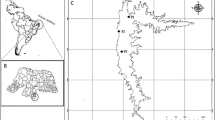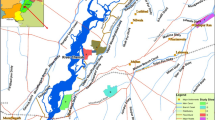Abstract
Exposure of animals and humans to different metal components through contaminated drinking water can result in a wide range of adverse clinical conditions. Toxicological consequences arising from the concurrent repeated exposure to multiple metal contaminants are not known. The purpose of the present study was to evaluate the oxidative stress-inducing potential of a mixture of eight metals (arsenic, cadmium, lead, mercury, chromium, nickel, manganese, iron), representative of groundwater contamination in different areas of India, in erythrocytes of male rats subchronically exposed to environmentally relevant doses via drinking water. The selection of these metals, as determined by literature survey of groundwater contamination in India, was primarily based on the frequency of their occurrence and contamination level above World Health Organization maximum permissible limit (MPL) in drinking water. Male albino Wistar rats were exposed to the metal mixture at 0, 1, 10, and 100 times the mode concentrations (the most frequently occurring concentration) of the individual metals in drinking water for 90 days. In addition, one group of rats was also exposed to the mixture at a concentration equal to the MPL of individual components. The oxidative stress in erythrocytes was evaluated by assessing the magnitude of malondialdehyde production and reduced glutathione (GSH) content and the activities of superoxide dismutase (SOD), catalase, glutathione peroxidase (GPx), and glutathione reductase (GR) after 30, 60, and 90 days of exposure. MPL and 1× dose levels did not cause any changes. The mixture at 10× and 100× doses caused dose- and time-dependent effects. After 30 days, the 10× dose did not cause any changes except increase in SOD activity. The 100× dose increased the activities of SOD, catalase and GR and the GSH level, but caused no alterations in lipid peroxidation (LPO) and GPx activity. After 60 days, the 10× dose did not cause any changes. The 100× dose increased LPO and decreased all the antioxidant parameters, except GSH. After 90 days, both 10× and 100× levels elevated LPO. The 10× dose decreased GSH level and activities of SOD and catalase, but not of GPx and GR, whereas the 100× dose decreased all the antioxidative systems. Overall, the present study demonstrates that the subchronic exposure of male rats to the mixture of metals via drinking water results in induction of oxidative stress and concomitant reduction in antioxidative defense system in erythrocytes at 10 and 100 times the mode concentrations of the individual metals in contaminated groundwater.
Similar content being viewed by others
References
Aebi HE (1983) Catalase. In: Bergmeyer HU, Bergmeyer J, Graßl M (ed) Methods of enzymatic analysis, 3rd ed., vol. III. Verlag Chemie, Weinheim, pp 273–286
Bulat P, Dujic I, Potkonjak B, Vidakovic A (1998) Activity of glutathione peroxidase and superoxide dismutase in workers occupationally exposed to mercury. Int Arch Occup Environ Health 71(suppl):S37–S39
De Mattia G, Bravi MC, Laurenti O, De Luca O, Palmeri A, Sabatucci A, Mendico G, Ghiselli A (2004) Impairment of cell and plasma redox state in subjects professionally exposed to chromium. Am J Ind Med 46:120–125
Demontis MP, Varoni MV, Volpe AR, Emanueli C, Madeddu P (1998) Role of nitric oxide synthase inhibition in the acute hypertensive response to intracerebroventricular cadmium. Br J Pharmacol 123:129–135
Ercal N, Gurer-Orhan H, Aykin-Burns N (2001) Toxic metals and oxidative stress Part I: mechanisms involved in metal-induced oxidative damage. Current Topics Med Chem 1:529–539
Eritsland J (2000) Safety considerations of polyunsaturated fatty acids. Am J Clin Nutr 71:197S–201S
Everse J, Hsia N (1997) The toxicities of native and modified hemoglobins. Free Radic Biol Med 22:1075–1099
Ferreira ALA, Machado PEA, Matsubara LS (1999) Lipid peroxidation, antioxidant enzymes and glutathione levels in human erythrocytes exposed to colloidal iron hydroxide in vitro. Braz J Med Biol Res 32:689–694
Flora SJ (1999) Arsenic-induced oxidative stress and its reversibility following combined administration of N-acetylcysteine and meso 2,3-dimercaptosuccinic acid in rats. Clin Exp Pharmacol Physiol 26:865–869
Goldberg DM, Spooner RJ (1983) Glutathione reductase. In: Bergmeyer HU, Bergmeyer J, Graßl M (ed) Methods of enzymatic analysis, 3rd ed., vol. III. Verlag Chemie, Weinheim, pp 258–265
Gregus Z, Klaassen CD (2001) Mechanism of toxicity. In: Klaassen CD (ed) Casarett and Doull’s toxicology: the basic science of poisons, 6th ed. McGraw-Hill, New York, pp 35–81
Gyurasics A, Varga F, Gregus Z (1991) Glutathione-dependent biliary excretion of arsenic. Biochem Pharmacol 42:465–468
Hatherill JR, Till GO, Ward PA (1991) Mechanisms of oxidant-induced changes in erythrocytes. Agents Actions 32:351–358
Hebbel RP (1986) Erythrocyte antioxidants and membrane vulnerability. J Lab Clin Med 107:401–404
Hoshmand AR (1998) Statistical methods for environmental and agricultural sciences. 2nd ed. CRC Press, New York, pp 9–47
Kanter M, Coskun O, Gurel A (2005) Effect of black cumin (Nigella sativa) on cadmium-induced oxidative stress in the blood of rats. Biol Trace Elem Res 107:277–288
Kasperczyk S, Birkner E, Kasperczyk A, Kasperczyk J (2005) Lipids, lipid peroxidation and 7-ketocholesterol in workers exposed to lead. Hum Exp Toxicol 24:287–295
Kasperczyk S, Kasperczyk A, Ostalowska A, Dziwisz M, Birkner E (2004) Activity of glutathione peroxidase, glutathione reductase, and lipid peroxidation in erythrocytes in workers exposed to lead. Biol Trace Elem Res 102:61–72
Kono Y, Fridovich I (1982) Superoxide radical inhibits catalase. J Biol Chem 257:5751–5754
Levonen AL, Laakso J, Vaskonen T, Mervaala E, Karppanen H, Lapatto R (2000) Down-regulation of renal glutathione synthesis by systemic nitric oxide synthesis inhibition in spontaneously hypertensive rats. Biochem Pharmacol 59:441–443
Madesh M, Balasubramanian KA (1998) Microtiter plate assay for superoxide dismutase using MTT reduction by superoxide. Indian J Biochem Biophys 35:184–188
Misiewicz A, Radwan K, Misiewicz A, Dziewit T (1999) Malonyl dialdehyde concentration in red blood cells of workers engaged in the production of iron-manganese alloys. Med Pr 50:277–281
Mittal CK, Harrell WB, Mehta CS (1995) Interaction of heavy metal toxicants with brain constitutive nitric oxide synthase. Mol Cell Biochem 149–150:263–265
Moellering D, McAndrew J, Patel RP, Cornwell T, Lincoln T, Cao X, Messina JL, Forman HJ, Jo H, Darley-Usmar VM (1998) Nitric oxide-dependent induction of glutathione synthesis through increased expression of γ-glutamylcysteine synthetase. Arch Biochem Biophys 358:74–82
Nagarathna KK (2001) Groundwater pollution. Centre for Environment Education-News and Feature Service (CEE-NFS), Vol. 2, pp 1–2. (http://education.vsnl.com/cee/index.html)
Paglia DE, Valentine WN (1967) Studies on the quantitative and qualitative characterization of erythrocyte glutathione peroxidase. J Lab Clin Med 70:158–169
Pi J, Kumagai Y, Sun G, Yamauchi H, Yoshida T, Iso H, Endo A, Yu LY, Yuki K, Miyauchi T, Shimojo N (2000) Decreased serum concentrations of nitric oxide metabolites among Chinese in an endemic area of chronic arsenic poisoning in inner Mongolia. Free Radic Biol Med 28:1137–1142
Pi J, Yamauchi H, Kumagai Y, Sun G, Yoshida T, Aikawa H, Hopenhayn-Rich C, Shimojo N (2002) Evidence for induction of oxidative stress caused by chronic exposure of Chinese residents to arsenic contained in drinking water. Environ Health Perspect 110:331–336
Prins HK, Loos JA (1969) Glutathione. In: Yunis JG (ed) Biochemical methods in red cell genetics. Academic Press, New York, pp 127–129
Quig D (1998) Cysteine metabolism and metal toxicity. Altern Med Rev 3:262–270
Sarkar S, Yadav P, Bhatnagar D (1997) Cadmium-induced lipid peroxidation and the antioxidant system in rat erythrocytes: the role of antioxidants. J Trace Elem Med Biol 11:8–13
Shafiq-Ur-Rehman (1984) Lead-induced regional lipid peroxidation in brain. Toxicol Lett 21:333–337
Sinet PM, Garber P (1981) Inactivation of human Cu-Zn superoxide dismutase during exposure to O2 and H2O2. Arch Biochem Biophys 212:411–416
Stohs SJ, Bagchi D, Hassoun E, Bagchi M (2000) Oxidative mechanisms in the toxicity of chromium and cadmium ions. J Environ Pathol Toxicol Oncol 19:201–213
Tavazzi B, Di Pierro D, Amorini AM, et al. (2000) Energy metabolism and lipid peroxidation of human erythrocytes as a function of increased oxidative stress. Eur J Biochem 267:684–689
Tian L, Lawrence DA (1996) Metal-induced modulation of nitric oxide production in vitro by murine macrophages: lead, nickel, and cobalt utilize different mechanisms. Toxicol Appl Pharmacol 141:540–547
Tkeshelashvili LK, Tsakadze KJ, Khulusauri OV (1989) Effect of some nickel compounds on red blood cell characteristics. Biol Trace Elem Res 21:337–342
Valko M, Morris H, Cronin MTD (2005) Metals, toxicity and oxidative stress. Current Med Chem 12:1161–1208
van Ginkel G, Sevanian A (1994) Lipid peroxidation-induced membrane structural alterations. Methods Enzymol 233:273–288
Vernhet L, Courtois A, Allain N, Payen L, Anger JP, Guilouzo A, Fardel O (1999) Overexpression of the multidrug resistance-associated protein (MRP1) in human heavy metal-selected tumor cells. FEBS Lett 443:321–325
Yang RSH, Rauckman EJ (1987) Toxicological studies of chemical mixtures of environmental concern at the National Toxicology Program: health effects of ground water contaminants. Toxicology 47:15–34
Acknowledgment
The Senior Research Fellowship awarded to the first author is gratefully acknowledged. The authors are thankful to the Director of the Institute for providing all necessary facilities for carrying out the present work.
Author information
Authors and Affiliations
Corresponding author
Rights and permissions
About this article
Cite this article
Jadhav, S.H., Sarkar, S.N., Aggarwal, M. et al. Induction of Oxidative Stress in Erythrocytes of Male Rats Subchronically Exposed to a Mixture of Eight Metals Found as Groundwater Contaminants in Different Parts of India. Arch Environ Contam Toxicol 52, 145–151 (2007). https://doi.org/10.1007/s00244-006-0053-z
Received:
Accepted:
Published:
Issue Date:
DOI: https://doi.org/10.1007/s00244-006-0053-z




